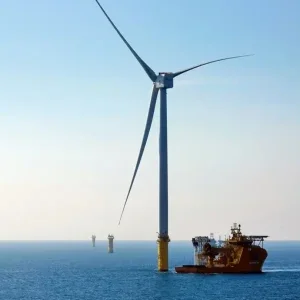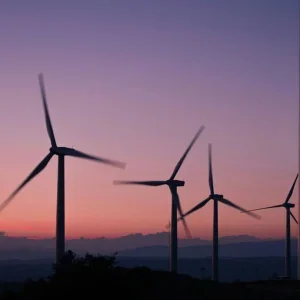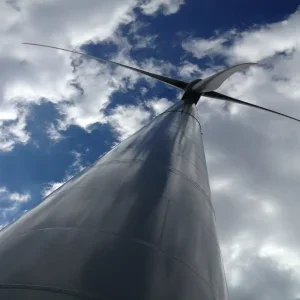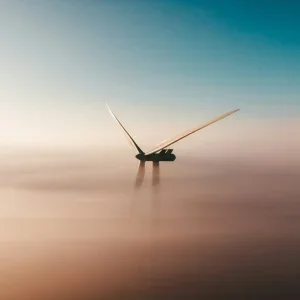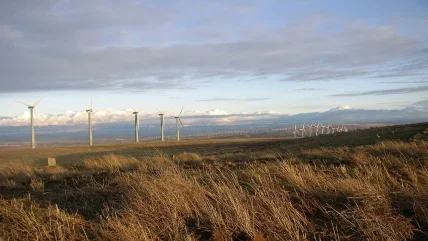
“We already have quite a lot of onshore wind. There will be more, over time, particularly where communities are in favour of it […] That is, I think, the key test of onshore wind – is it of benefit to communities locally? That has always been the principle for us, for quite some time now.”
These words, spoken in November by the UK’s business and energy secretary, Grant Shapps, indicated quite the turnaround for the Conservative government’s party line on onshore wind. Rishi Sunak, the current prime minister, had vocally opposed new onshore wind development during his leadership campaign against Liz Truss in the summer of 2022, which he would go on to lose.
Truss, during her infamously short tenure as the UK’s PM, looked set to overturn a de facto ban on onshore wind development that has been a part of Conservative policy since 2015, back in the Cameron years. After Sunak took her place in October 2022, he indicated that he would return to the status quo in this area and maintain the onshore wind ban.
What a difference a month or two can make – as both Truss and Sunak have learned. By late November 2022, Sunak was forced into this U-turn by growing discontent among Tory backbenchers. Supporters of scrapping the onshore wind ban include leading Conservatives like Truss and former PM Boris Johnson, as well as the Labour party – Sunak’s main opposition.
A disunited kingdom
However, even with this about-turn, the onshore wind industry still faces a great number of challenges in the UK, as it does throughout Europe and the US. Of course, notes James Robottom, head of onshore wind at RenewableUK, when looking at onshore wind in the UK, it’s important to highlight the key differences between Scotland, England, Wales and Northern Ireland.
In terms of planning and support for the onshore wind sector, Scotland is far ahead of its fellow UK nations. RenewableUK, the UK’s leading not-for-profit renewable energy trade association, has been pushing for a target of 30GW of onshore wind across the UK by 2030. About 12GW of this new capacity has been earmarked for Scotland, which would take its total capacity to just over 20GW. The Scottish government has offered its support for this target, which makes the challenges in this nation different from those posed elsewhere in the UK.
7
The number of years it takes on average to build and connect a new onshore wind turbine in the UK, despite the fact that this could be done in a year.
Octopus Energy
“The biggest issue in Scotland is about the speed at which we can get stuff done,” explains Robottom. Octopus Energy, a British renewable energy group, has stated that a big challenge with onshore wind development in the UK is that the current system means it takes seven years on average to build and connect a new onshore wind turbine, despite the fact that this could be done in a year.
England, on the other hand, remains in the firm grasp of the Conservative party’s de facto ban on onshore wind farms – though, as noted earlier, this soon could change. Onshore wind is one of the cheapest and quickest forms of energy to build and consistently polls positively with the British public. A September 2022 YouGov survey found 87% of people would support a wind turbine in their community if it meant cheaper energy.
And yet, the way that planning laws in England are written, any onshore wind development can only happen in areas identified by a local authority, which often don’t have the knowledge or resources to carry out that kind of wind assessment. At the same time, Robottom notes that “there is a very challengingly worded stipulation around community support, which basically means that one very vocal opponent can block an entire wind project”.
In Wales, on the other hand, grid issues are the main stumbling block. “The biggest challenge in Wales is a lack of grid, not even a lack of grid investment – there is just no grid in mid-Wales,” Robottom notes, despite the country possessing some of the best onshore wind resources across the UK. The lack of grid infrastructure has proved a consistent challenge across the UK – however, this isn’t simply an issue for the wind industry, but one that has affected solar power, housing projects, and every other kind of infrastructure.
From a repowering perspective, the UK also faces a number of challenges. While repowering has typically been exempt from the restrictions on onshore wind in the UK, these projects are fundamentally new projects, requiring new foundations and an upgraded grid connection. This development can bring about local opposition – particularly from those unwilling to see a taller, larger turbine put in the place of the previous model.
In Scotland, Robottom has seen what he calls “a really good move” from the fourth National Planning Framework (NPF4), which involved providing consent in perpetuity for wind farms. In essence, this means that when you’re developing a repowering project, it will not be treated as a new site, but instead be viewed as a continuous wind turbine site.
Robottom also notes that one of the main challenges facing the global wind industry concerns a deficiency in key skills. While the onshore industry can’t compete with offshore in terms of technicians and skills, he believes they instead should be working to complement each other, envisioning a future where people enter the industry and gain experience through working on onshore projects, before moving on to floating wind and then bigger projects offshore.
The rest of the West
The UK onshore wind industry isn’t the only one with obstacles to overcome, of course. For example, while 2022 has seen some positive moves for the wind industry in the US, such as the passing of the Inflation Reduction Act – part of which looks to invest in domestic energy production while promoting clean energy – there is a lot of uncertainty over how this policy will be implemented, how the tax credits will be applied, and how big of an impact it will have on the development of the local supply chain.
As we’ve, lingering policy uncertainty is plaguing onshore wind across the world. In Europe, permitting delays are one of the main issues effecting onshore wind, with the market hesitant to invest due to global instability and market uncertainty. At the same time, with the best wind resources already used by windfarms – forcing new projects to move closer to population centres – and wind turbine sizes growing larger and larger, public opposition is also likely to increase in the coming years.
Aaron Barr, global head of onshore wind energy at Wood Mackenzie, highlights a recent proposal by the European Commission to try to accelerate the permitting process for renewable energy sources. Under the proposal, renewable energy projects “would be presumed to be of overriding public interest” and benefit from shorter permitting procedures, which range from one month for solar rooftop installations to six months for the repowering of large wind farms. However, these kinds of drastic solutions, while much needed, can also run the risk of backfiring if local communities feel these projects are being forced upon them.
Similarly, onshore wind has been negatively impacted by a rapid consolidation of the market, Barr notes, with only a handful of large turbine manufacturers competing for every project. “What we’ve seen over the past few years is very, very intense price competition for new turbine orders – and that’s part of the thing that’s driven negative profitability,” says Barr. “All of these OEMs are now signalling that they need to increase price in order to offset some of the cost increases they’ve seen in the supply chain – but they’re still competing with each other on these new turbine orders.”
At the same time, we’ve seen the continued evolution of auctions and tariffs for new power generation from wind in Germany, France and Spain. However, these auctions have often gone undersubscribed. “The cost situation has just turned so upside down right now that that many developers are not pursuing the auctions,” explains Barr. An auction in Spain in November saw the lowest-ever award of capacity to onshore wind, with only 45.5MW secured across two projects out of a possible 1.5GW.
The long lead time for wind turbine parts, helped in no way by the ongoing global supply chain crisis, has further complicated issues. Wind turbine manufacturers that signed orders a year or two ago, when prices were at a record low, have since been hit by increasing costs, leaving them stuck delivering equipment at unprofitable prices. At the same time, the industry is dealing with a considerable amount of excess manufacturing capacity left over from 2020, a massive year for wind turbine construction, which has ultimately led to lower profitably and layoffs across much of the supply chain.
The profitability challenges faced by wind turbine manufacturers has driven them to globalise their supply chains in recent years, sourcing labour from low-cost countries, says Barr. However, these cost savings have been outweighed by recent spikes in the cost of logistics. “Shipping blades, towers and drive trains across the world is now much more expensive than it was, which has really outweighed some of the cost savings that they were trying to use by moving into those countries,” Barr notes. “It’s really become a perfect storm for the wind supply chain.”
For these reasons and more, Barr notes that most wind turbine manufacturers have had to accept that they won’t be able to return to profitability until the end of 2023 at the earliest. Onshore wind is just one part of this market, but it’s fair to say the next few years will be trying ones unless policymakers work to help address these concerns. After all, we need every tool in our arsenal if we’re going to combat climate change, and onshore wind has a key role to play – if it’s allowed to flourish.
45.5MW
The total capacity secured across two projects at an auction in Spain in November 2022 out of a possible 1.5GW – the lowest-ever awarded.
Renews


